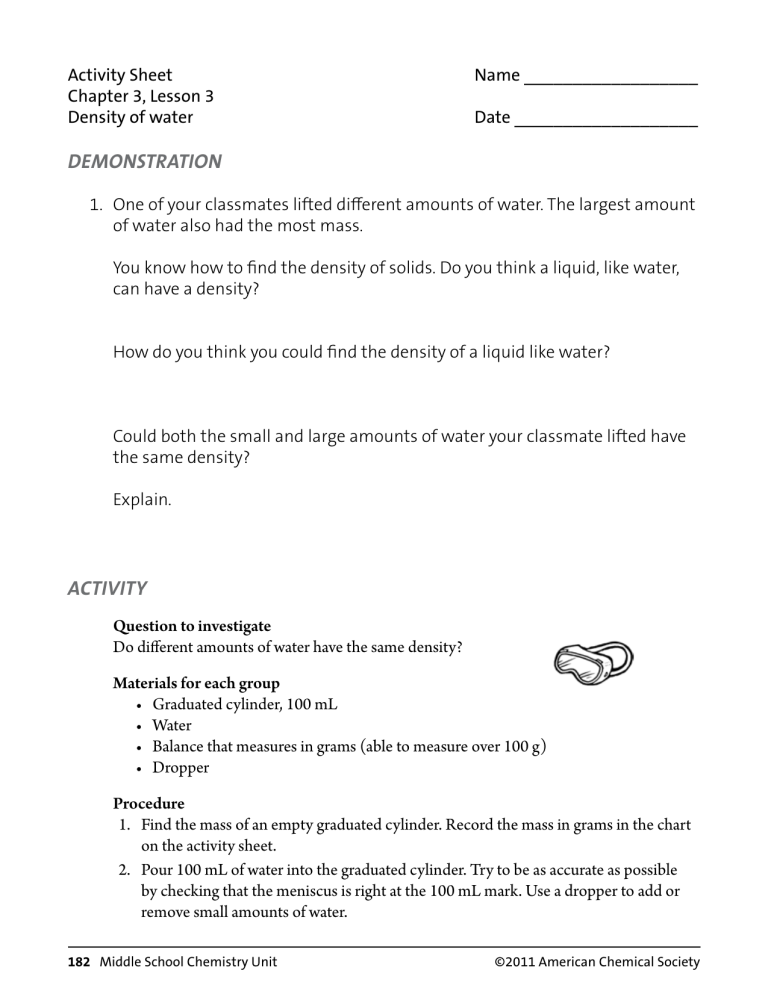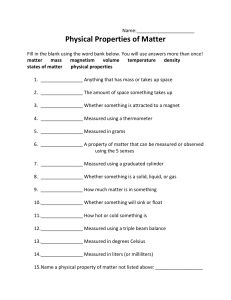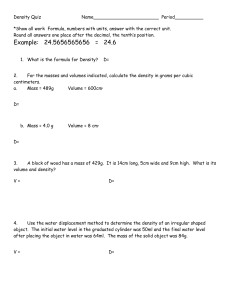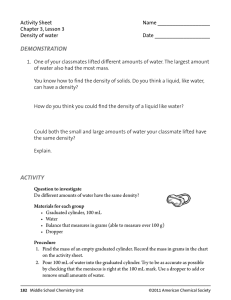
Activity Sheet Chapter 3, Lesson 3 Density of water Name __________________ Date ___________________ DEMONSTRATION 1. One of your classmates lifted different amounts of water. The largest amount of water also had the most mass. You know how to find the density of solids. Do you think a liquid, like water, can have a density? How do you think you could find the density of a liquid like water? Could both the small and large amounts of water your classmate lifted have the same density? Explain. ACTIVITY Question to investigate Do different amounts of water have the same density? Materials for each group • Graduated cylinder, 100 mL • Water • Balance that measures in grams (able to measure over 100 g) • Dropper Procedure 1. Find the mass of an empty graduated cylinder. Record the mass in grams in the chart on the activity sheet. 2. Pour 100 mL of water into the graduated cylinder. Try to be as accurate as possible by checking that the meniscus is right at the 100 mL mark. Use a dropper to add or remove small amounts of water. 182 Middle School Chemistry Unit ©2011 American Chemical Society 3. Weigh the graduated cylinder with the water in it. Record the mass in grams. 4. Find the mass of only the water by subtracting the mass of the empty graduated cylinder. Record the mass of 100 mL of water in the chart. 5. Use the mass and volume of the water to calculate density. Record the density in g/cm3 in the chart. 6. Pour off water until you have 50 mL of water in the graduated cylinder. If you accidentally pour out a little too much, add water until you get as close as you can to 50 mL. 7. Find the mass of 50 mL of water. Record the mass in the activity sheet. Calculate and record the density. 8. Next, pour off water until you have 25 mL of water in the graduated cylinder. Find the mass of 25 mL of water and record it in the chart. Calculate and record the density. Finding the density of different volumes of water Volume of water 100 milliliters 50 milliliters 25 milliliters Mass of graduated cylinder + water (g) Mass of empty graduated cylinder (g) Mass of water (g) Density of water (g/cm3) 2. Look at your values for density in your chart. Does the density of the different volumes of water seem to be about the same? 3. What do you think is the density of water in g/cm3? ©2011 American Chemical Society Middle School Chemistry Unit 183 4. Using the data from your chart, graph the volume and mass for 100 mL, 50 mL, and 25 mL. Volume vs. Mass for Water at Room Temperature Volume vs. Mass for Water at 25°C 110 100 90 80 Mass (g) 70 60 50 40 30 20 10 0 0 10 20 30 40 50 60 70 80 90 100 110 Volume (mL) 5. Look at the graph you made. If you measured 40 milliliters of water, what do you think its mass would be? What would its density be? Volume: 40 mL Mass ___________ Density _________ 6. Choose any volume of water between 1 and 100 milliliters. Based on the graph, what would its mass be? What would its density be? Volume _________ Mass ___________ Density _________ 184 Middle School Chemistry Unit ©2011 American Chemical Society 7. Density is a “characteristic property” of a substance. This means that the substance will have the same density no matter how big or small the sample is. Would you say that density is a characteristic property of water? Why or why not? EXPLAIN IT WITH ATOMS & MOLECULES Each individual molecule has the same size and mass. The water molecules are packed very close together the same way throughout an entire sample of water. 8. Sample B is half the volume of Sample A. Do the samples have the same mass? Sample A Sample B Do the samples have the same density? ©2011 American Chemical Society Middle School Chemistry Unit 185 TAKE IT FURTHER 9. The density of a liquid is the same no matter the size of the sample. Could this be true for solids, too? Calculate the density of each of the three samples to find out. Sample A has a mass of 200 g. What is the density of Sample A? If you cut Sample A in half and looked at only one half you would have Sample B. What is the density of this Sample B? If you cut Sample B in half you would have Sample C. What is the density of Sample C? 186 Middle School Chemistry Unit ©2011 American Chemical Society



